Can Convenience Stores Play Role In Lifting Fresh Produce Consumption?
May 4, 2022 | 19 min to read
In an era where fresh produce consumption is declining, Convenience Stores (C-stores) are emerging as vital players in promoting healthier eating habits. With over 151,000 C-stores in the U.S., strategic in-store placement and suggestive selling are crucial for increasing produce sales. Partnerships between the National Association of Convenience Stores and the Partnership for A Healthier America have bolstered availability, especially in food deserts. Overall, effective supply chains and consumer education are essential for enhancing fruit and vegetable sales in these retail environments.
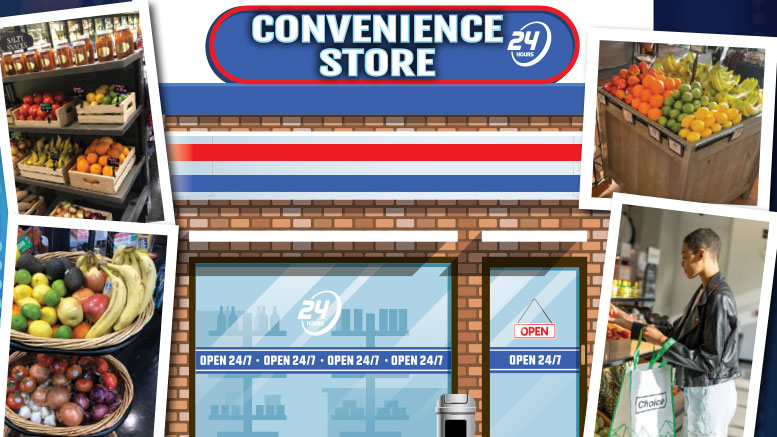
In-store placement and suggestive selling have the most significant impact on sales of produce in C-stores.
Originally printed in the April 2022 issue of Produce Business.
Something small but mighty might be the answer to moving the needle on fresh fruit and vegetable consumption: Convenience Stores (C-stores).
This is a powerful idea, considering American’s intake of produce isn’t just flat, but has declined by 3% over the past five years, according to the 2021-released State of the Plate: America’s Fruit and Vegetable Consumption Trends, by the Produce for Better Health Foundation (PBH), Brentwood, MO.
Now, what if the 151,000-plus C-stores nationwide — 1 per every 2,100 Americans — sold some or sold more fresh produce? It could be a banana at the register, fresh-cut melon cups in reach-in refrigerated units, or lettuce-based salads along with hot dogs at C-store prepared food counters.
Consider the potential if just half or a quarter of the 1,100 customers who shop at stores selling fuel each day — or some 160 million C-store customers a year, according to the Alexandria, VA-headquartered National Association of Convenience Stores (NACS) — bought a single produce item? Add this to the fresh produce shoppers purchase in supermarkets and restaurants and the potential is huge.
“When we opened our first gas station 25 years ago, bananas, apples and oranges were the only offerings. Now, at our Hy-Vee Fast & Fresh stores, the first of which opened in 2018, we sell 42 fresh produce SKUs,” says Josh Asche, senior vice president and chief operating officer at Hy-Vee, a West Des Moines, IA-headquartered chain with 180 stores in eight Midwestern states.
“Success in selling an expanded selection of fresh produce didn’t happen overnight. It’s not easy, but we’ve taken a long view with a vision of where we want to be 10 years from now. The numbers, like produce sales growing over the past year at 30%, tell us we’re on the right path. And this is incremental to produce sales at our regular grocery stores.”
A TWO-DECADE EVOLUTION
The first convenience stores opened in the U.S. in the 1920s and 1930s. Some were outlets for dairies selling milk, and others sold gas to the newly motoring public. Following World War II, Americans’ move to the suburbs and road trip family vacations meant more driving, and service stations popped up in a soup-to-nuts of locations. To cater to these customers, C-store operators sold motor oil and windshield wiper fluid, as well as cold drinks and pre-packaged nonperishable snack foods.
“Success in selling an expanded selection of fresh produce didn’t happen overnight. It’s not easy, but we’ve taken a long view with a vision of where we want to be 10 years from now.”
— Josh Asche, Hy-Vee Fast & Fresh
“It used to be if you saw a banana in a C-store, you thought it was left out from an employee’s lunch.
What has changed over the years is the distribution to these stores,” says Jeff Lenard, vice president of strategic industry initiatives for NACS. “Back when delivery was one to two times a week, it was important to have shelf-stable items. As the industry has grown and the way people shop has changed, C-stores have evolved in terms of their supply chains. Some have become vertically integrated; others have formed partnerships with distributors and perishables suppliers. The result is deliveries can be up to four to five times a week, a platform that can successfully support fresh produce. You could call this evolution a two-decade overnight success.”
To build on this, the NACS and the Washington, DC-headquartered Partnership for A Healthier America (PHA) partnered in 2017. PHA is the nonprofit created in combination with, but separate from, former First Lady Michelle Obama’s Let’s Move! initiative launched in 2010 dedicated to helping children and families lead healthier lives. One of PHA’s key initiatives is called Shifting Retail Environments, which joins with retailers such as NACS members to make healthy choices easy and convenient. One result to date was expanding nutritious options in more than 2,500 C-stores nationwide. Some 75% of these stores are in food-scarce areas, often called food deserts.
“Many communities across the country lack access to a grocery store and rely on their local convenience store for food. Together, through our strategic partnership with NACS, we have increased the amount and variety of fresh produce at convenience stores nationwide by providing individual retailers with a framework for healthier options,” says Stacy Molander, PHA’s chief operating officer.
There’s another reason many C-store operators are embracing perishables like produce.
“Today, we drive less, smoke less and are eating healthier, so the C-store model has to change,” says Mike Fogarty, founder and chief executive officer of Choice Market, a three-store operation based in Denver, CO.
“We founded Choice in 2017 by rethinking what a C-store could and should be. For us, that’s fresh produce for sale in-store and a from-scratch kitchen with several produce-rich offerings on the menu. We also have charging stations for electric cars, AI-enabled cashier-less checkouts and the potential of putting locations in hospitals, airports, universities and even shipping containers.”
HEALTH & CONVENIENCE IN THE DRIVER’S SEAT
It’s one thing to offer fresh produce and another for customers to be motivated to buy. However, trends toward healthier eating are fueling this transition. For example, nearly all (96%) of Americans say they pay at least some attention to healthful eating, according to the 2022 Power of Produce report, by the Arlington, VA-based Food Marketing Institute (FMI). Additionally, six in 10 buy items for special health and nutrition benefits, and apples, bananas, berries, oranges, broccoli and spinach top the list.
Convenience also remains king. Over three-fourths (83%) of consumers said convenience was even more important to them now than five years ago, according to the Winter 2020 Consumer View report, by the National Retail Federation, headquartered in Washington, D.C. What’s more, most (97%) said they have pulled out of a purchase because it was inconvenient for them. In contrast, consider the unmatched transaction speed in a C-store of 3 to 4 minutes, based on NACS Speed Metrics Research, with only 71 seconds of this dedicated to selecting an item or items.
“We don’t see the need for convenience or fresh foods slowing down, and neither should the produce industry. This category is still in its infancy compared to other products in C-stores. We’ve found that a ‘build it, and they will come’ attitude has proven tremendous results,” says Marissa Dake, director of communications and public affairs for DNO Produce, a Columbus, OH-based produce distributor and processor for partners in foodservice, food manufacturing and retail.
BEST-SELLERS — WHOLE & FRESH-CUT
C-stores cater to the needs of customers where they live, work and play. Operators, therefore, don’t necessarily have a cookie-cutter approach to fresh produce. Plus, offerings are a mix of whole fruits and vegetables as well as fresh cuts.

PHOTO COURTESY OF CHOICE MARKET
“We have nine stores. Some are on the interstate, some are in communities, and some are in-between. That means our produce model varies with the demographic of the store’s location,” says Don Rhoads, president of The Convenience Group (TCG) LLC, in Vancouver, WA, which operates under the Minit Mart Stores banner and fashions itself as a superette with core perishables and nonperishables.
“On the interstate, maybe it’s an apple, orange, or banana that we bundle with a sandwich and cookie or chip as part of our lunchbox program. Or in communities, where people are coming home from work, it’s all about fill-in’s to the regular weekly pantry shop. This means baking potatoes, garlic, avocados, tomatoes, onions — both yellow and red — for making dinner, and lemons and limes for beverages. We’ve seen demand for fresh and for a more diverse produce mix accelerated by the pandemic.”
This theme resonates at Hy-Vee’s Fast & Fresh stores, albeit more by the time of day. “In the morning, customers get apples, oranges and bananas with coffee before work. In the afternoon and evening, big movers are apple slices and dips and baby carrots for kids on the way to soccer practice, or potatoes, onions, green and red peppers and bagged salads for making dinner,” says Asche.
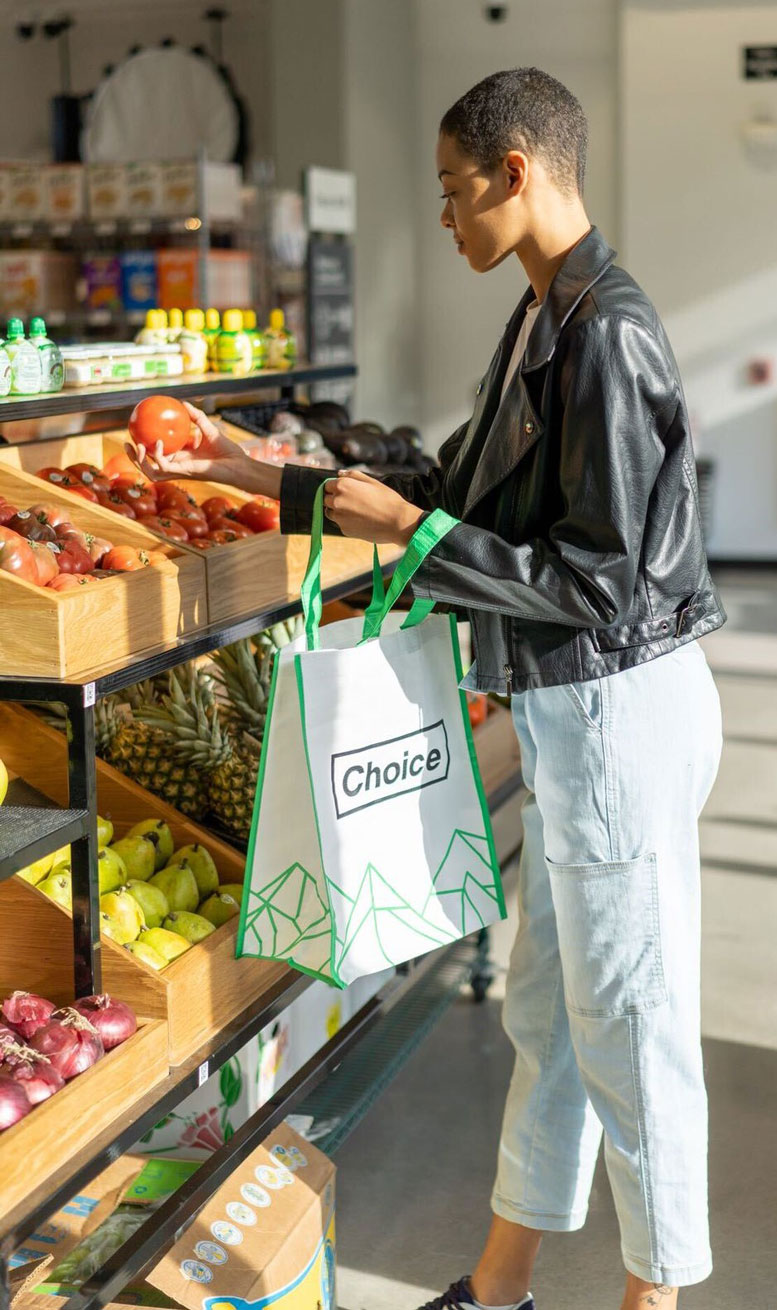
Whole fruits, namely bananas, apples and oranges, have historically been the first foot-in-the-door produce offerings in C-stores. They remain among the most successful when it comes to registering rings. Case in point, Asche says Hy-Vee’s Fast & Fresh stores sell $1,500 to $2,000 worth of bananas a week. These sales are up 45% in the past year, compared to 30% for produce overall, he says.
Similarly, Landhope Farms, a three-unit C-store headquartered in Kennett Square, PA, sells about 70,000 single bananas a year.
“A fresh banana, Red Delicious apple or Granny Smith apple, coupled with a yogurt or granola bowl, is a great ‘start of the day’ purchase for any convenience store patron,” says Dennis McCartney, director of operations. “Carrots are big sellers, too. Our flagship location, located in Unionville, PA, is right in the middle of horse country. Our customers are not only here to purchase for themselves, but for their horses as well — which makes 10-pound bags of carrots a very popular item.”
Have some fun and go the next mile, recommends Benjamin Walker, senior vice president of sales, marketing and merchandising for Baldor Specialty Foods, in Bronx, NY. “Maybe offer a Ruby Frost rather than a Red Delicious or a sumo instead of a navel. It’s a chance to use fresh produce as a differentiator.”
In January, Sun Pacific, the Pasadena, CA-based grower/marketer of Cuties brand clementines, partnered with large convenience distributors Core-Mark International and Eby-Brown to distribute its three-pack bags of Cuties. The reach of these two distributors, both owned by the Performance Food Group in Richmond, VA, is some 50,000 C-stores nationwide.
SNACKS, BUT MEALS SELL TOO
The continuing snacking trend is ripe for revving sales of fresh-cut fruits and vegetables in C-stores. Consider that 22% of Americans snack much or somewhat more often than five years ago, and that over half are replacing a meal with a snack at breakfast (60%), lunch (74%) and dinner (59%), according to At the Dining Table 2021: American Meals & Cooking, by the Hartman Group, in Bellevue, WA. Add to this that NACS research shows 84% of food items purchased in this channel are eaten within an hour. If nothing else, look at the multiplication of cup holders in cars. Late-model family minivans boast 10 to 15.
Some C-store operations such as Landhope Farms cut produce in-house, balancing ever-increasing costs with quality, packaging and waste control.
The continuing snacking trend is ripe for revving sales of fresh-cut fruits and vegetables in C-stores.
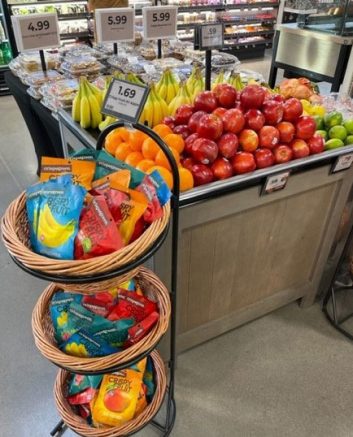
“During the winter here in Pennsylvania, we decrease the number of fresh fruits that are cut and packaged in the store, simply because the demand decreases, and it’s an opportunity for waste to wreak havoc on the bottom line. However, in the summertime, we routinely get fresh pineapples, mangos, kiwi, apples, pears and cut those to offer our customers a fresh bowl of fruit as an alternative to the routine breakfast sandwich,” says McCartney.
Supplying fresh-cut produce to the C-store industry can be a profitable opportunity for produce suppliers.
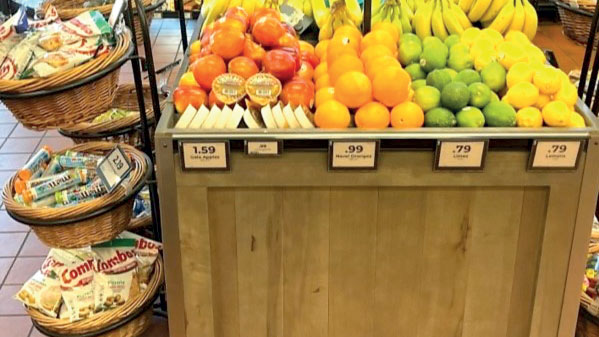
PHOTO COURTESY OF HY-VEE FAST & FRESH
“The beauty of our fresh-cut offerings is that they allow C-store operators to focus on what they do best: running their business,” says DNO Produce’s Dake. “We streamline the procurement and prep for them, taking care of the labor, nonconsumable parts of the product (pineapple crowns, stems, leaves), and ensure food safety. Plus, we have the space at our facilities to do it; something that can be hard to come by in a corner store. As a result, our most popular offerings in this category are sliced melons (like cantaloupe, watermelon, and honeydew), pineapple, carrot sticks, and mixed fruit cups.”
Fruit tends to be more popular for snacking than vegetables, says Tony Freytag, executive vice president of Crunch Pak, in Cashmere, WA, which offers kid-targeted sliced apple snack products, often combined with other produce like grapes and non-produce items such as cheese and nuts, under its Disney-themed Foodles and Nickelodeon character Paw Patrol brands. “These are easy to eat out of hand and in transit.”

However, vegetables are increasingly key players in fresh-cut snack produce. A good example is Baldor Specialty Foods’ trio of healthful snacks sold under its Urban Roots line. These include single-serve 4-ounce crudité packs with baby cucumbers, cut radishes and a Gotham Greens Vegan Goddess dressing, and 3-ounce each packets of carrots and celery sticks with vegan buffalo dip and sugar snap peas with a ginger miso dip.
New is Cal-Organic Farms’ organic carrot chips and dips. The three-item line comes with carrot chips packaged with hummus, guacamole, or ranch dip in 5-ounce ready-to-eat packs.
“Convenience store operators will love the ease to handle and merchandise the product packed in a display-ready case. Distribution of this product began last year, and consumer response to date has been very encouraging,” says David Bright, vice president of marketing for Grimmway Farms, in Bakersfield, CA, of which Cal-Organic is a subsidiary.
Fresh-cuts that easily serve as meals include pre-made salads. Ready Pac Foods Inc., in Irwindale, CA, has sold its Bistro Bowls into the C-store channel for nearly 10 years.
“The most popular salad bowls at convenience stores mirror consumer preference at the grocery store level,” says Todd Root, director of sales. “Bowls such as our Chicken Caesar Salad, Turkey and Bacon Cobb, Chef and Santa Fe Style are consistently in high demand. We are also noticing our larger-sized bowls, such as our Bistro Gourmet bowls, are rising in popularity as C-store consumers are looking for more filling meal options. Our Gourmet bowls range from 9.5- to 11.5-ounces and offer nearly twice the amount of meat protein as our regular Bistro bowls. They also include a fork for immediate consumption, which makes them an ideal option for grab and go.”
C-stores that do on-site food preparation also integrate fresh produce into their programs. At Choice Market, smoothies, salads and build-your-own bowls are big sellers. Salads include an Avocado Cobb, Kale Caesar and Winter Harvest, the latter with greens, roasted beets, carrots and Brussels sprouts. Bowls feature a Red Curry with winter vegetables and Steak & Potato filled with Yukon Gold mashed potatoes and green beans.
“We source organic produce grown locally when possible and we change the menu seasonally every three to four months,” says Fogarty at Choice Market. “That means chard and root vegetables in the winter and BLTs with heirloom tomatoes in the summer. We are also plant-forward in our offerings and fresh produce is a big part of that.”
Sourcing fresh produce for sale or in food prep isn’t always easy for C-store operators.
“We use fresh lettuce, tomatoes and onions on our sandwiches. Sometimes, we’ve had to send someone out to the grocery store to buy tomatoes. It works, but it’s not the best,” says Lisa Dell’Alba, president and chief executive officer of Square One Markets, Inc., a 10-store convenience chain based in Easton, PA.
BUMPS IN THE ROAD
Sourcing a steady supply and maintaining a high quality of fresh fruits and vegetables for sale, plus letting customers know the product is there are two huge hurdles.
“C-stores thrive by giving customers back time. But when it comes to fresh produce and perishability, time is not on our side,” says Square One’s Dell’Alba.
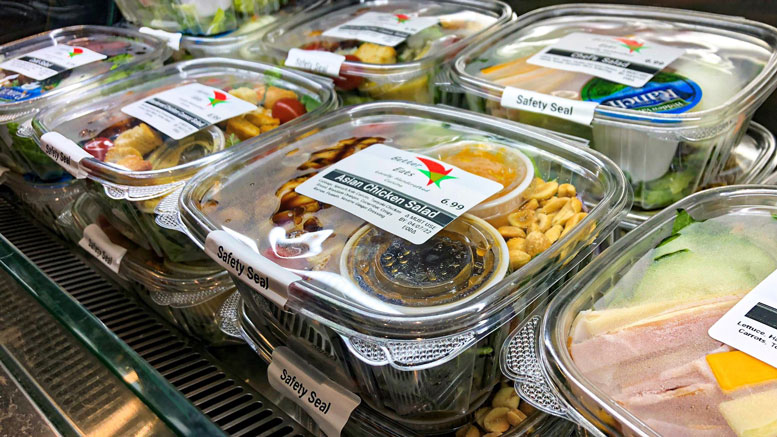
PHOTO COURTESY OF CONVENIENCE GROUP
The supply chain remains the most important aspect in getting fresh produce to C-stores and food deserts, according to Jennifer Watts, vice president of business development at Taylor Farms, in Salinas, CA. “Having a higher delivery frequency allows for a wide variety of products and fresh, shorter shelf-life items that arrive to store shelves at the perfect stage of ripeness. The increased quality of the product drives customer satisfaction and leads to increased, repeated purchases.”
If C-store operators don’t have the critical mass to drive a successful custom program, the key is to partner with suppliers, distributors, and other operators.
“We coordinate daily or next-day deliveries or pickups with our convenience store partners,” says Kirk Teske, vice president, product management and sales, fresh-cut N.A., for Del Monte Fresh Produce, in Coral Gables, FL. “In many cases, we deliver into commissaries that also produce sandwiches, salads and other nonproduce refrigerated items. Our process eliminates obstacles for convenience stores and helps continue to incrementally grow sales.”
Supplying a variety is easier with industry partners too. For instance, S. Abraham & Sons (SAS), a Grand Rapids, MI-based subsidiary of Harahan, LA-headquartered convenience distributor, Imperial Trading Co., which serves some 3,500 convenience stores in eight Midwest states, has set up a cross-docking program with Sysco Corporation, headquartered in Houston, TX.
If C-store operators don’t have the critical mass to drive a successful custom program, the key is to partner with suppliers, distributors, and other operators.
“If our C-store customers order apples, for example, it looks like it’s from SAS, but it’s a Sysco item. We have 150 items set up with Sysco that our stores can order, from apples, oranges and bananas to lettuce, tomato and onions and more. We don’t hold any produce inventory, but we can deliver it to the small C-stores we service with grocery items that don’t hit Sysco’s delivery minimum. If a customer only wants two or three SKUs, we can do that,” says Heather Campbell, vice president of foodservice.
Letting customers know fruits and vegetables are available is crucial and doesn’t happen overnight.
“Customers see fresh produce in a C-store and think, ‘that’s interesting’. On the second visit, they think ‘oh, it’s still there.’ On the third, maybe six months after first seeing it, they purposely come in to purchase it,” explains the NACS’ Lenard.
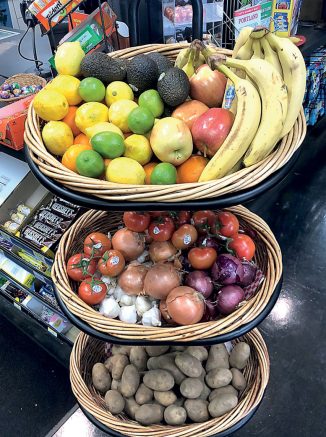
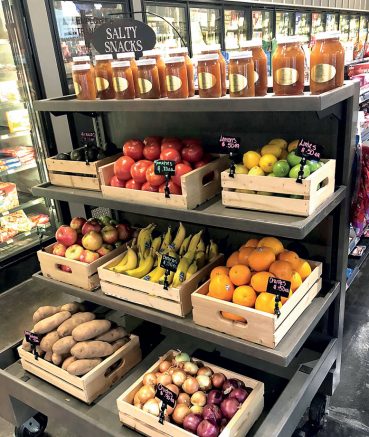
The in-store placement has the most significant impact on sales of produce in C-stores, according to TCG’s Rhoads. “We have hand fruit, like bananas, in three to four baskets up at the cash register. On dry case shelving, either inline or on an endcap upfront, we’ll have assorted potatoes, onions, avocados and garlic. Refrigerated and fresh-cut produce is sold next to other freshly prepared foods like salads and sandwiches. So, that’s three locations with healthful choices in our stores.”
Tell customers how to solve an immediate problem, recommends the NACS’ Lenard. “Sign a basket of fruit ‘Great for Breakfast’ to boost sales.”
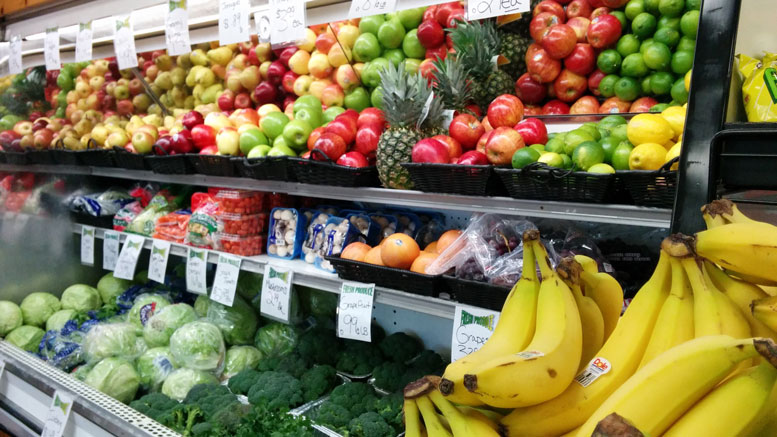
Consumers are amenable to paying a higher price point for the immediacy and convenience of this purchasing experience. However, produce pricing in C-stores should also be competitive with traditional supermarkets for optimal sales, says TCG’s Rhoads.
“We’ll offer promotions like Gala apples or navel oranges 2 for $1.59 instead of 99 cents apiece to encourage customers to pick up two,” says Hy-Vee Fast & Fresh’s Asche.
Promotions beyond price are effective for calling out that a C-store carries fresh produce.
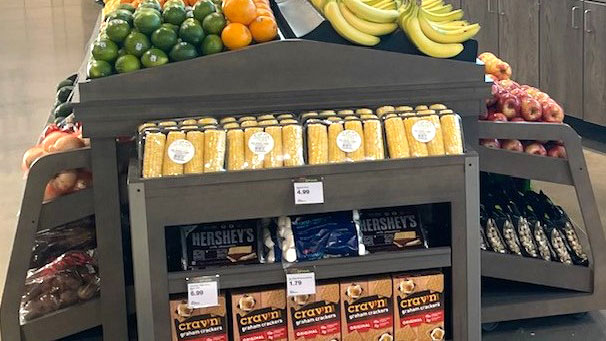
PHOTO COURTESY OF HY-VEE FAST & FRESH
“One of the things that makes our Unionville store unique is its produce stand in the summer months,” says Landhope Farms’ McCartney. “For years, we have had a local grower set up a farm stand in our parking lot that has become a fixture for the community. It sells everything from fresh strawberries, blueberries, peaches and much more, to converting to a pumpkin and mum stand in September for the autumn season. We routinely get calls asking if Juan has opened the produce stand yet as we get closer to June. That has helped our transition inside the store to offer more variety during the summer and continue the tradition of what our customers are looking for during the winter months.”
Looking ahead, says Wendy Reinhardt Kapsak, MS, RDN, PBH president and chief executive officer, “making produce available at C-stores is the perfect example of an easy, grab-and-go solution that will help improve fruit and vegetable consumption.”
Three Ways Produce Suppliers Can Successfully Sell To C-Stores
There are several opportunities for the produce industry to supply fresh fruits and vegetables to convenience stores (C-stores). However, C-stores aren’t mini versions of traditional supermarkets. Their urban-to-rural locations, small store size and speed of customer shop all offer challenges as well as possibilities. Here are three suggestions from C-store retailers of how the produce industry can help put more fresh fruits and vegetables in store:
INDUSTRY EDUCATION. Education is key, says Don Rhoads, president of The Convenience Group (TCG), LLC, in Vancouver, WA, which operates under the Minit Mart Stores banner. “Produce suppliers eager to service our channel need to take a deep dive into our business and how it operates. Doing so often creates an opportunity.”
This is what happened for Crunch Pak, a sliced apple and fresh-cut snack produce supplier in Cashmere, WA. “We saw that the National Association of Convenience stores hosted an annual convention. When we started to do research, out of the hundreds of vendors, only two were produce-oriented. That led us to learn more and work on the logistics needed to supply these customers,” says Tony Freytag, executive vice president.
SHRINK & SHELF LIFE. One of the biggest struggles historically for C-store operators is determining sales velocity and minimizing shrink. Customers are typically buying just one thing to eat immediately. It’s not a pantry-filling type of shopping, says Mike Fogarty, founder and chief executive officer of Choice Market, a three-unit chain in Denver, CO.
“That’s why many operators stick with apples, bananas and oranges. Since our model was food-focused from day one, with our own scratch kitchens, we control shrink by moving product from the shelf to the kitchen to use in prepared foods preparation. It’s harder for legacy C-stores to do this successfully.”
That’s where shelf life comes in.
Generally, the shelf life of a fresh product at the C-store level is shorter than for grocery stores because C-stores typically get deliveries less frequently, says Todd Root, director of sales for Ready Pac Foods, Inc., in Irwindale, CA. “We’re constantly looking at ways to innovate our process to expand the shelf-life window for convenience stores. One way we’ve adapted is by carving out more C-store businesses on the coasts, closer to our plants. This has allowed us to narrow that delivery window and gives our Bistro Bowls an even longer shelf life at C-stores.”
Another example is S. Abraham & Sons (SAS) new salad program. The Grand Rapids, MI-based subsidiary of Harahan, LA-headquartered convenience distributor, Imperial Trading Co., which serves some 3,500 retailers in eight Midwest states, switched its Fruit Ridge Farms brand salads to locally grown lettuce from Revolution Farms. The hydroponic greenhouse is located 20 miles south in Caledonia, MI.
“This move means we can provide prepared salads and lettuce blends that go from farm to store in less than two days,” says Heather Campbell, vice president of food service for SAS. “We can also make salads on demand now for convenience operators, from one salad a week or more, with no maximum or minimum.”
QUANTITY. A barrier to C-store retailers ordering fresh produce for stores is large quantities.
“We are on our third tomato SKU,” says Josh Asche, senior vice president and chief operating officer of the West Des Moines, IA-headquartered Hy-Vee Fast & Fresh, with 180 stores in eight midwestern states. “First, we bought 20-pound boxes, but the stores couldn’t sell through this quantity fast enough. Then, we went to 11-pound boxes of tomatoes on the vine. This was better, but there was still shrink and displays looked dirty with leaves and stems. Now we have packages of three tomatoes that come eight units in a case. There’s no mess, no need to throw anything away, we can turn the small cases and the product is always fresh. The same is true of bananas. Forty-pound cases don’t work well. We order 10-pound cases.”
DNO Produce, a Columbus, OH-based produce distributor and processor for partners in food service, food manufacturing and retail, provides tailored solutions to its customers, says Marissa Dake, director of communications and public affairs. “For example, to keep turns tight for a C-store chain, we’ll build master cases in packs of four instead of eight to allow for tighter turns of the product at the store level.”
18 of 18 article in Produce Business May 2022

